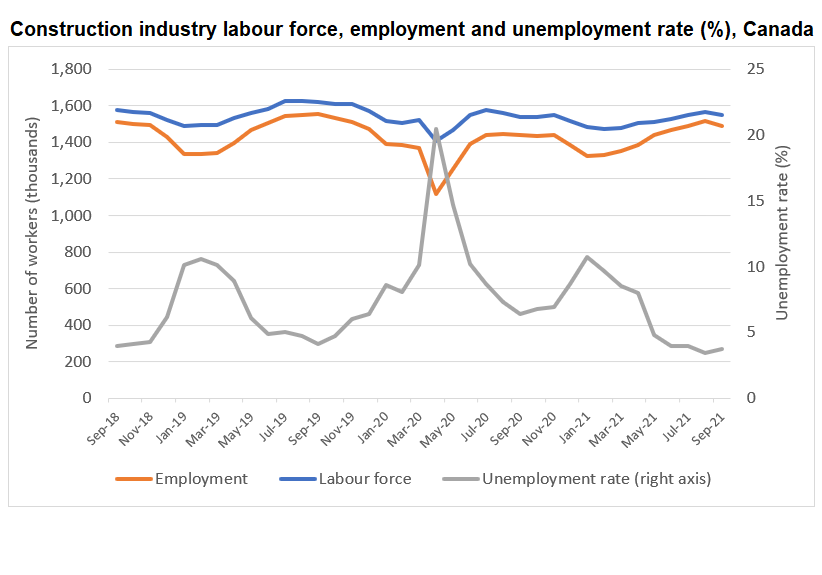The latest Labour Force Survey data from Statistics Canada shows good news. All-industry seasonally adjusted employment rose for the fourth consecutive month in September and returned at last to pre-pandemic levels. September’s gain of 157,000 (0.8%) was mostly concentrated in full-time employment.
Statistics Canada collected the data during the week of September 12 to 18, and at that time, provinces were managing several key issues relating to COVID-19. Proof-of-vaccination requirements were made mandatory in several provinces, while some regions of the country had also re-introduced indoor masking requirements. In Alberta in particular, employers were urged to pause employee return-to-work plans.
Meanwhile, the September reference week saw the new school year begin across the country, a fact that affected labour market conditions for students as well as parents.
Construction employment declines, but remains near historic highs
Construction’s seasonally unadjusted numbers for September tell a more nuanced story. The industry shed 24,300 workers during the month. This represented a drop of 1.6% and was the first decline in industry employment since January. It was also likely the product of the cyclical nature of the industry.
The larger industry employment picture shows strength. Month to month, employment in 2021 has been either at or above historic levels. Employment in September, for example, was 3.8% (+54,300 workers) ahead of employment in the same period last year.

Newfoundland and Labrador and Prince Edward Island were the only provinces to report month-over-month gains in employment in September, increasing 1.6% and 3.4% respectively. Employment was relatively unchanged in Ontario, Manitoba, and Quebec, with each province seeing fluctuations in employment of less than 1% from the previous month. The remaining provinces saw declines in employment compared to August, with Nova Scotia and Saskatchewan reporting drops of 4.7% and 4.6% respectively.
Most provinces also reported gains in industry employment over September 2020. At 7% and 6.1% respectively, Quebec and Ontario reported the greatest gains, with many other provinces reporting gains of 5% or lower. Year-over-year employment was lower in Prince Edward Island (-17.6%), New Brunswick (-2.9%), Alberta (-2.0%), and Nova Scotia (-0.8%).
The industry’s unemployment rate reported a modest rise (+0.3%), as the September decline in employment (-24,000 workers, -1.6%) was slightly higher than the decline in the labour force (-19,800 workers, -1.3%). The number of hours worked continues to rise. National total hours worked rose 4.8% in September, compared to September 2020 levels.
Meanwhile, Statistics Canada’s report on job vacancies in the second quarter of 2021 suggests that job vacancies in the construction sector have hit an all-time high.
Vacancies in the industry rose by 19,900 (+46.7%) over two years to reach 62,600 in the second quarter of 2021 – the highest total ever recorded. Increases were highest among trade contractors, where vacancies rose by 14,300 (+53%), followed by the construction of buildings subsector (+4,400, +40.8%).
Demand for workers is rising, particularly as the total investment in building construction continues to increase. Amid such demand factors, the unemployed-to-job vacancy ratio for construction fell to 1:3 in the second quarter of 2021, and according to the Canadian Survey on Business Conditions, recruiting skilled employees was expected to be an obstacle for more than one-third (35.2%) of construction businesses, compared with 27.8% of all businesses.

